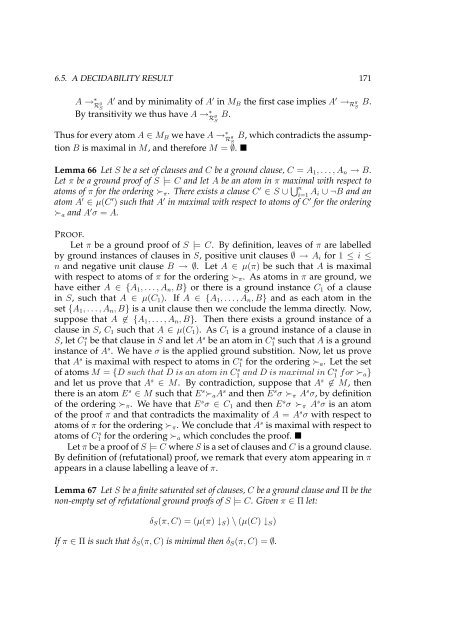Logical Analysis and Verification of Cryptographic Protocols - Loria
Logical Analysis and Verification of Cryptographic Protocols - Loria
Logical Analysis and Verification of Cryptographic Protocols - Loria
Create successful ePaper yourself
Turn your PDF publications into a flip-book with our unique Google optimized e-Paper software.
6.5. A DECIDABILITY RESULT 171<br />
A → ∗<br />
R g<br />
S<br />
A ′ <strong>and</strong> by minimality <strong>of</strong> A ′ in MB the first case implies A ′ → R g<br />
S B.<br />
By transitivity we thus have A → ∗<br />
R g<br />
S<br />
Thus for every atom A ∈ MB we have A →∗ R g B, which contradicts the assump-<br />
S<br />
tion B is maximal in M, <strong>and</strong> therefore M = ∅. �<br />
Lemma 66 Let S be a set <strong>of</strong> clauses <strong>and</strong> C be a ground clause, C = A1, . . . , An → B.<br />
Let π be a ground pro<strong>of</strong> <strong>of</strong> S |= C <strong>and</strong> let A be an atom in π maximal with respect to<br />
atoms <strong>of</strong> π for the ordering ≻π. There exists a clause C ′ ∈ S ∪ � n<br />
i=1 Ai ∪ ¬B <strong>and</strong> an<br />
atom A ′ ∈ µ(C ′ ) such that A ′ in maximal with respect to atoms <strong>of</strong> C ′ for the ordering<br />
≻a <strong>and</strong> A ′ σ = A.<br />
PROOF.<br />
Let π be a ground pro<strong>of</strong> <strong>of</strong> S |= C. By definition, leaves <strong>of</strong> π are labelled<br />
by ground instances <strong>of</strong> clauses in S, positive unit clauses ∅ → Ai for 1 ≤ i ≤<br />
n <strong>and</strong> negative unit clause B → ∅. Let A ∈ µ(π) be such that A is maximal<br />
with respect to atoms <strong>of</strong> π for the ordering ≻π. As atoms in π are ground, we<br />
have either A ∈ {A1, . . . , An, B} or there is a ground instance C1 <strong>of</strong> a clause<br />
in S, such that A ∈ µ(C1). If A ∈ {A1, . . . , An, B} <strong>and</strong> as each atom in the<br />
set {A1, . . . , An, B} is a unit clause then we conclude the lemma directly. Now,<br />
suppose that A �∈ {A1, . . . , An, B}. Then there exists a ground instance <strong>of</strong> a<br />
clause in S, C1 such that A ∈ µ(C1). As C1 is a ground instance <strong>of</strong> a clause in<br />
S, let C s 1 be that clause in S <strong>and</strong> let A s be an atom in C s 1 such that A is a ground<br />
instance <strong>of</strong> A s . We have σ is the applied ground substition. Now, let us prove<br />
that A s is maximal with respect to atoms in C s 1 for the ordering ≻a. Let the set<br />
<strong>of</strong> atoms M = {D such that D is an atom in C s 1 <strong>and</strong> D is maximal in C s 1 for ≻a}<br />
<strong>and</strong> let us prove that A s ∈ M. By contradiction, suppose that A s �∈ M, then<br />
there is an atom E s ∈ M such that E s ≻aA s <strong>and</strong> then E s σ ≻π A s σ, by definition<br />
<strong>of</strong> the ordering ≻π. We have that E s σ ∈ C1 <strong>and</strong> then E s σ ≻π A s σ is an atom<br />
<strong>of</strong> the pro<strong>of</strong> π <strong>and</strong> that contradicts the maximality <strong>of</strong> A = A s σ with respect to<br />
atoms <strong>of</strong> π for the ordering ≻π. We conclude that A s is maximal with respect to<br />
atoms <strong>of</strong> C s 1 for the ordering ≻a which concludes the pro<strong>of</strong>. �<br />
Let π be a pro<strong>of</strong> <strong>of</strong> S |= C where S is a set <strong>of</strong> clauses <strong>and</strong> C is a ground clause.<br />
By definition <strong>of</strong> (refutational) pro<strong>of</strong>, we remark that every atom appearing in π<br />
appears in a clause labelling a leave <strong>of</strong> π.<br />
Lemma 67 Let S be a finite saturated set <strong>of</strong> clauses, C be a ground clause <strong>and</strong> Π be the<br />
non-empty set <strong>of</strong> refutational ground pro<strong>of</strong>s <strong>of</strong> S |= C. Given π ∈ Π let:<br />
B.<br />
δS(π, C) = (µ(π) ↓S) \ (µ(C) ↓S)<br />
If π ∈ Π is such that δS(π, C) is minimal then δS(π, C) = ∅.
















